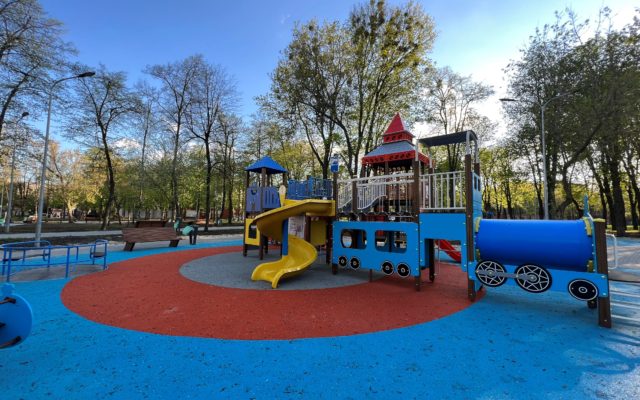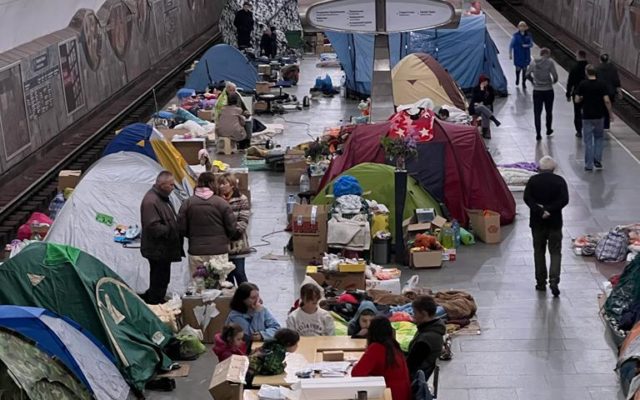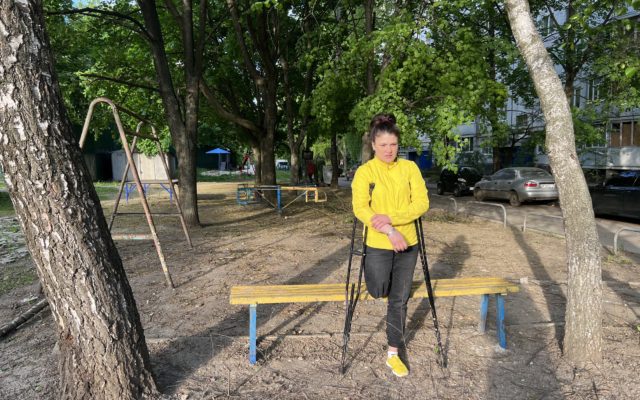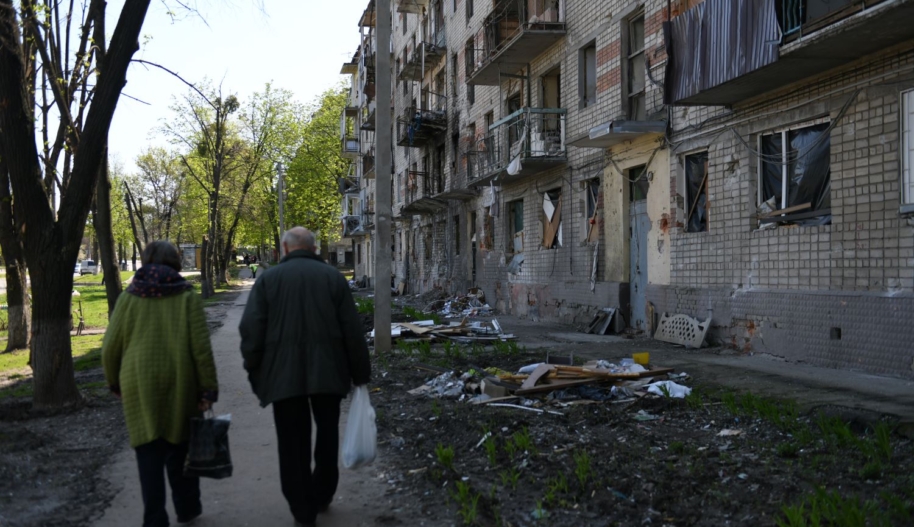Hundreds of civilians have been killed in the Ukrainian city of Kharkiv by indiscriminate Russian shelling using widely banned cluster munitions and inherently inaccurate rockets, Amnesty International said today.
A new report, ‘Anyone can die at any time’: Indiscriminate attacks by Russian forces in Kharkiv, Ukraine, documents how Russian forces have caused widespread death and destruction by relentlessly bombarding residential neighbourhoods of Kharkiv since their invasion began in late February.
During an extensive investigation, Amnesty International found evidence of Russian forces repeatedly using 9N210/9N235 cluster munitions as well as scatterable mines, both of which are subject to international treaty bans because of their indiscriminate effects.
“The people of Kharkiv have faced a relentless barrage of indiscriminate attacks in recent months, which killed and injured hundreds of civilians,” said Donatella Rovera, Amnesty International’s Senior Crisis Response Adviser.
“People have been killed in their homes and in the streets, in playgrounds and in cemeteries, while queueing for humanitarian aid, or shopping for food and medicine.
“The repeated use of widely banned cluster munitions is shocking, and a further indication of utter disregard for civilian lives. The Russian forces responsible for these horrific attacks must be held accountable for their actions, and victims and their families must receive full reparations.”
The director of the Medical Department at the Kharkiv Regional Military Administration told Amnesty International that 606 civilians had been killed and 1,248 injured in the Kharkiv region since the conflict began. Most of the strikes investigated by Amnesty International inflicted multiple casualties over widespread areas.
While Russia is not a party to either the Convention on Cluster Munitions or the Convention on Anti-Personnel Mines, international humanitarian law prohibits indiscriminate attacks, and the use of weapons that are indiscriminate by nature. Launching indiscriminate attacks resulting in death or injury to civilians, or damage to civilian objects, constitutes war crimes.

PLAYGROUND ATTACK
The bombardment of Kharkiv, home to 1.5 million people, started on 24 February when the Russian invasion of Ukraine began. Residential neighbourhoods in the northern and eastern parts of the city bore the brunt of the shelling.
On the afternoon of 15 April, Russian forces fired cluster munitions in and around Myru Street, in the Industrialni neighbourhood. At least nine civilians were killed and more than 35 injured, including several children. Doctors at Kharkiv’s City Clinical Hospital 25 showed Amnesty International metal fragments they had removed from patients’ bodies, including the distinctive pieces of steel rods contained in 9N210/9N235 cluster munitions.
Tetiana Ahayeva, a 53-year-old nurse, was standing by the entrance of her building when several cluster bombs exploded. She told Amnesty International: “There was a sudden sound of firecrackers everywhere, lots of them, all over. I saw puffs of black smoke where the explosions occurred. We dropped to the ground and tried to find cover. Our neighbour’s son, a 16-year-old boy called Artem Shevchenko, was killed on the spot… His father had a shattered hip and a shrapnel wound in his leg. It’s hard to say how long the explosions lasted; a minute can seem to last forever.”
In a nearby playground, Oksana Litvynyenko, 41, suffered devastating injuries when several cluster munitions exploded while she was walking with her husband Ivan and their four-year-old daughter. Shrapnel penetrated her back, chest and abdomen, puncturing her lungs and spine. She tragically died on 11 June. The strike took place in the middle of the afternoon, while many other families were at the playground with their children.
Ivan told Amnesty International on 26 April: “All of a sudden, I saw a flash… I grabbed my daughter and pushed her against the tree and hugged the tree, so that she was protected between the tree and my body. There was a lot of smoke, and I couldn’t see anything… Then as the smoke around me eased, I saw people on the ground… my wife Oksana was lying on the ground. When my daughter saw her Mum on the ground in a pool of blood, she said to me, ‘Let’s go home: Mum is dead and the people are dead’. She was in shock and so was I. I still don’t know whether my wife will recover; the doctors cannot say if she will be able to speak or walk again. Our world has been turned upside down.”
After more than one month in intensive care, Oksana’s condition had improved slightly, but she died from her injuries on 11 June. Amnesty International researchers found the distinctive fins and metal pellets and other fragments from the 9N210/9N235 cluster munitions at the playground. Several small craters in the concrete ground were also visible, consistent with the damage expected from the explosion of such munitions.

All of a sudden, I saw a flash… I grabbed my daughter and pushed her against the tree and hugged the tree, so that she was protected between the tree and my body
Ivan Litvynyenko, playground attack survivor.
HUMANITARIAN QUEUE STRIKE
At least six people were killed and 15 were injured on the morning of 24 March, when cluster munitions struck a parking lot near the Akademika Pavlova metro station where hundreds of people were queuing for humanitarian aid.
Valeriia Kolyshkina, a sales assistant in a pet shop close to the scene of the strike, said that one man was killed when the explosions destroyed the glass front of a nearby store.
She told Amnesty International: “A man was killed just outside the shop. He was standing outside smoking while his wife was buying pet food… Metal shrapnel came through the front window, flying over my head as I was behind the counter. Then there were several more explosions. It was utter panic. The shop was full of people. We ran to the storage room at the back of the shop for protection. It was very scary… I thought I would die.”
Ruslan*, a local policeman who witnessed the attack, said: “It was really a horrible situation, shrapnel was falling like rain.”
Amnesty International researchers found parts of a 220mm Uragan rocket, which carries 30 submunitions, still embedded in a crater in the tarmac. Around the area, they also found fins and fragments from the 9N210/9N235 cluster munitions, and multiple other craters.
Two other cluster munitions also hit the roof of the Holy Trinity Church, approximately 500 metres from where the rocket landed. The church serves as a humanitarian hub where volunteers prepare food and aid packages to be distributed to people who struggle to access humanitarian assistance distribution points, such as older people and those with disabilities and reduced mobility. Pastor Petro Loboiko and Pastor Serhii Andreiivich showed Amnesty International shrapnel from two cluster munitions that had penetrated the church’s walls and doors after exploding on the roof.

It was utter panic. The shop was full of people. We ran to the storage room at the back of the shop for protection. It was very scary… I thought I would die
Valeriia Kolyshkina, a sales assistant in a pet shop close to the scene of the strike.
LOST LIMBS
On the afternoon of 12 March, Veronica Cherevychko, a 30-year-old logistics manager and mother, lost her right leg when a Grad rocket struck a playground in front of her home in the Saltivka neighbourhood.
She told Amnesty International: “I was sitting on this bench when the explosion happened. I remember hearing a whistling sound just before the explosion. Then I woke up in hospital, without a leg; my right leg was gone. Now my life is divided into before 12 March, and after 12 March. I will get used to this. Now I am not yet used to it; I often try to touch my leg, to scratch my foot… I don’t know what to say about [the] people who did it. I will never understand them.”
Three people were killed and six injured when a series of cluster munitions exploded in the same neighbourhood on the morning of 26 April. Olena Sorokina, a 57-year-old cancer survivor, lost both legs in the blast. She was sitting outside her building waiting for a delivery of humanitarian aid when she heard the sound of a flying shell and ran to the entrance of the building.
Olena blacked out, then woke up in an ambulance and realized that she had lost a leg. She was taken to hospital, where her other leg also had to be amputated. She is now in western Ukraine, hoping to be transferred to a rehabilitation facility elsewhere in Europe. Olena told Amnesty International: “After the battle with cancer, now I have to face another battle to learn to function without legs.”
Unguided rockets – such as Grads and Uragans, which have been routinely used by Russian forces – are inherently inaccurate, making them indiscriminate when used in populated areas. Unguided artillery shells have a margin of error of over 100 metres. In residential areas where buildings are no more than a few metres apart, such inaccuracies are virtually certain to cost civilian lives and cause widespread destruction and damage to civilian infrastructure.
Ukrainian forces, for their part, often launched strikes from residential neighbourhoods, endangering civilians in those areas. Such a practice violates international humanitarian law, but does not in any way justify Russian forces’ repeated indiscriminate strikes.

I don’t know what to say about [the] people who did it. I will never understand them
Veronica Cherevychko, a 30-year-old logistics manager who lost her right leg.
METHODOLOGY
Amnesty International researchers investigated 41 strikes (which killed at least 62 people and injured at least 196) and interviewed 160 people in Kharkiv over 14 days in April and May, including survivors of attacks, relatives of victims, witnesses, and doctors who treated the injured. The organization’s researchers collected and analysed material evidence from strike locations, notably munitions fragments, as well as an array of digital materials.
All of Amnesty International’s ongoing documentation of violations of human rights and international humanitarian law committed during the war in Ukraine is available here.













